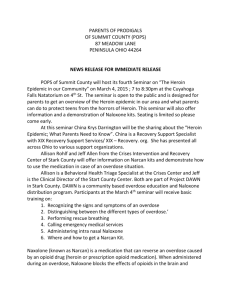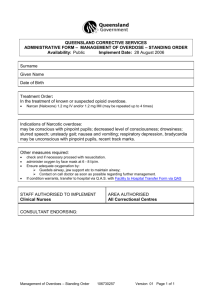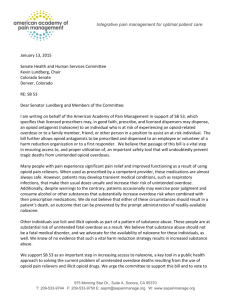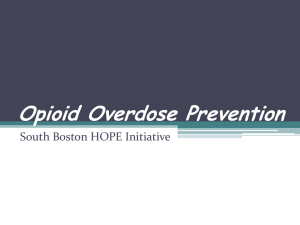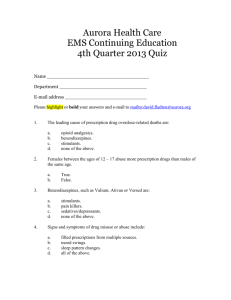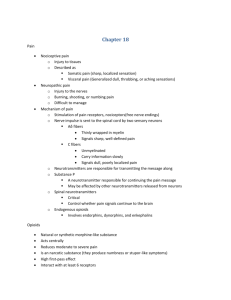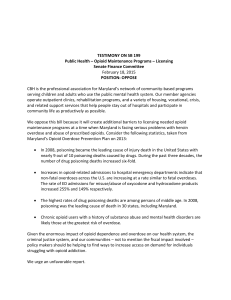CALL 911 - Massachusetts Technical Assistance Partnership for
advertisement
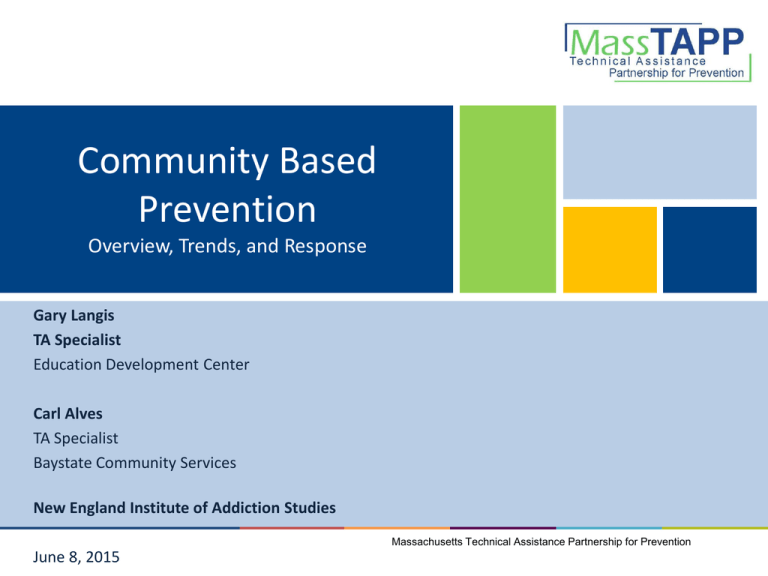
Community Based Prevention Overview, Trends, and Response Gary Langis TA Specialist Education Development Center Carl Alves TA Specialist Baystate Community Services New England Institute of Addiction Studies Massachusetts Technical Assistance Partnership for Prevention June 8, 2015 The MassTAPP Team Kat Allen, Amanda Doster, Rachel Stoler, Jeanette Voas Tracy Desovich, Lauren Gilman, Gary Langis, Alfredo Hernandez, Ben Spooner, Sue Vargo, Aubrey Ciol Carl Alves, Alejandro Rivera, Deborah Milbauer http://masstapp.edc.org 2 Web Site: http://masstapp.edc.org 3 AGENDA • 2:15 - Welcome and introductions • 2:30 - Scope, Opioids and Naloxone background/history • 3:45 - Break • 4:00 - OD- State Strategies • 4:45 – Local Strategies • 5:30 - Adjourn Welcome! Introductions Name, Where you’re from, What you do, What you’d like to get from this workshop. Scope of the Problem National Drug Threat Cocaine Heroin Meth Marijuana Controlled prescription drugs Regional Drug Threat 8 Percentage of NDTS Respondents Reporting High Heroin Availability in their Jurisdictions 9 10 http://www.scribd.com/doc/185260574/DEA-2013-National-Drug-Threat-Assessment 17 18 http://www.samhsa.gov/data/NSDUH/2012SummNatFindDetTables/NationalFindings/NSDUHresults2012.pdf 19 Heroin • The number of past year heroin users nearly doubled between 2007 (373,000) and 2012 (669,000) • The number of people with heroin dependence or misuse doubled between 2002 – 2012 (467,000 to 214,000) • The largest increase of heroin use among young adults 18-25 • Treatment admissions for heroin misuse among 18-25 increased from 11% to 26% between 2008 and 2012 http://www.samhsa.gov/data/NSDUH/2012SummNatFindDetTables/NationalFindings/NSDUHresults2012.pdf 20 The Road to Heroin is Paved with NMUPD • Half of young people who inject heroin surveyed in 3 recent studies report misusing prescription opioids before starting to use heroin • Some individuals reported switching to heroin because it is cheaper and easier to obtain than prescription opioids ($80/pill versus $5/bag) 21 Youth and Pills • Many youth believe pills are safer than illegal drugs because it is ‘medicine’ and prescribed from a doctor • After marijuana, pills most common to get high • Two thirds of teens start using pills before age 16 • 70% get them from a friend or relative • About 14% to 20% used prescriptions not prescribed to them in past year. 9% past month 22 Media Articles • Miami Herald: There are signs that heroin is returning as a cheap alternative to prescription pills, the by-product of Florida’s successful crackdown on pill mills. • USA Today, Posted April 23, 2013: In Charlotte, many of the opiate addicts in the Carolinas clinic got their start with powerful painkillers prescribed after surgery or a broken bone… As doctors cut off their prescriptions and the black market supply withered, they turned to cheaper, easier-to-find heroin…"A lot of dealers, if you buy nine balloons, they give you one free," he says. "You can call or text a dealer, and they'll deliver.“ • Portland Press Herald, May 12, 2013: “North New England seeing surge in heroin” Authorities are attributing the surge to aggressive marketing by out-of-state drug dealers and the higher cost of prescription drugs Emergency Room Opioid Prescriptions • Between 2001-2010, number of opioids prescribed in US emergency rooms increased 50% • Significant increase in hydrocodone, hydromorphone, morphine, and oxycodone prescriptions • Emergency room visits for pain only increased 4% 24 Mazur-Amirshahi et al, “Rising Opioid Prescribing in Adult US ED Visits 2001-2010”, Journal Academic Emergency Medicine, March 2014 25 Corey Montieth, Heath Ledger, Phillip Seymour Hoffman, Amy Winehouse, Whitney Houston, Chris Farley, and ? Not Just Celebrities 26 Overdose • 38,329 overdose deaths in US in 2010 • Unintentional poisoning leading cause of death Ages 25-64 (CDC, 2010) • US overdose deaths have increased for 11th consecutive year in a row • Now exceeds motor vehicle deaths for (probably) 7th year in a row (was 3rd year in a row in 2010) Centers for Disease Control and Prevention. “Pharmaceutical Overdose Deaths, United States, 2010,” in the Journal of the American Medical Association (JAMA). http://webappa.cdc.gov/cgi-bin/broker.exe 27 Deaths are the tip of the iceberg $37,274 per 1 OD SAMHSA NSDUH, DAWN, TEDS data sets Coalition Against Insurance Fraud. Prescription for Peril. http://www.insurancefraud.org/downloads/drugDiversion.pdf 2007. 28 Drug overdose deaths outnumbered motor vehicle traffic deaths in 10 states in 2005 More deaths from drug overdose CDC NVSS, MCOD. 2010 29 By 2010, drug overdose deaths outnumbered motor vehicle traffic deaths in 31 states More deaths from drug overdose CDC NVSS, MCOD. 2010 30 Overdose Deaths by Drug CDC, Wonder database 31 NMUPD OD’s More than quadrupled since 1999 2010 16,000+ Women Increasing faster than men 32 Prescription opioid sales, deaths and treatment: 1999-2010 National Vital Statistics System, 1999-2008; Automation of Reports and Consolidated Orders System (ARCOS) of the Drug Enforcement Administration (DEA), 1999-2010; Treatment Episode Data Set, 1999-2009 Overdose in Dollars $20.4 billion per year • $2.2 billion direct costs (inpatient, ED, MDs, ambulance) • $18.2 billion indirect costs (lost productivity from absenteeism and mortality) • $37,274 cost per opioid overdose event • Spent $2.6 m in May in Lynn, MA – 69 OD’s in May. 11 fatal. Police, ambulance, hospital Inocencio TJ et al. Pain Medicine 2013 34 Rate of Unintentional Opioid Overdose Deaths Massachusetts Residents, 2000-2013 Rate per 100,000 Residents 12.0 10.0 8.5 7.3 8.0 6.0 4.0 10.1 9.5 9.4 5.3 6.7 8.1 8.6 10.1 9.2 9.1 8.0 7.1 Increase of 10% in 1 year Doubled from 2000 2.0 0.0 MA DPH Registry of Vital Records and Statistics, April 2014 ‘Fatal Opioid-related Overdoses among MA Residents’, 2000-2013 Number of Unintentional Opioid Overdose Deaths, MA Residents, 2000-2014 Opioid-Related Deaths, Unintentional/Undetermined Massachusetts: 2000-2014 Confirmed Estimated Number of deaths 1,200 1,000 967 800 888 600 615 549 468 400 200 456 429 614 525 1,008 668 561 599 2008 2009 603 600 526 338 0 2000 2001 2002 2003 2004 2005 2006 2007 2010 2011 2012 2013 MA DPH Registery of Vital Records and Statistics April 2014 ‘Fatal Opioid-related Overdoses among MA Residents’, 2000-2013 2014 Oveview of Opioids Natural, Semi-Synthetic and Synthetic Opioid = Opiate. The term “opioid” designates a class of drugs •Natural opiates •Semi-synthetic opioids •Opioids manufactured synthetically “Opioid” is the broader term that includes the natural opiates in the poppy plant as well as chemicals that have been synthesized in some way to resemble an opiate Opioids Natural Morphine Codeine Semi-synthetic Heroin Oxycodone Fully synthetic Fentanyl Methadone Buprenorphine Opioids Opiates The term opiate is often used as a synonym for opioid, but it is more properly limited to the natural opium alkaloids and the semi-synthetics derived from them Natural Opioids Semi-Synthetic Opioids Fully Synthetic Opioids opium morphine codine heroin hydromorphone hydrocodone oxycodone fentanyl methadone Dilaudid Substances from all categories of opioids carry risk of overdose!!! Opioids 42 Most commonly used opioids • • • • • • • • • Heroin Codeine Demerol Morphine Darvocet Fentanyl Dilaudid Methadone Opium • • • • • • • • • Hydrocodone Oxycodone Levorphanol Vicodin OxyContin Tylenol 3 Tylox Percocet Percodan 43 DEA Alert - Desmethyl Fentanyl 44 What’s the difference ? Vicodin Opioids and Heroin Oxycontin hours opium opium morphine morphine codeine codeine days heroin heroin hydrocodone hydrocodone oxycodone oxycodone fentanyl fentanyl methadone methadone Demerol Demerol Street and Prescription Opioid Slang • Heroin • Dope, H, Brown, Sheila, Betty, Hayron, Manteca, Montaga, Diesel/Diz, Dog Food, China White, Smack, Boy, Chiba • Oxycodone • OC’s, Oxycotton, Perc 30s, Oxy’s, Roxy’s, Oscars, Big Boys • Percocet • Percs • Vicodin • Vike’s, Morph, Cottons, Watson 387 Non-Opioid Prescription Slang • Benzodiazepines – Downers, Benzos, Chill Pills, Tranx, Pins, Bars, Zani Bars (Prescribed for anxiety, insomnia, nausea) • Clonidine – Deans (Prescribed for blood pressure, anxiety, opioid withdrawal) • Phenergan or promethazine – Finnegan (Prescribed for nausea) • Klonopin+clonidine+phenergan: – The Cocktail (Used by methadone patients to boost methadone) • Neurontin (gabapentin) – Johnnies (Prescribed for seizures, mood stabilization, neuropathy) Overdose 101 What is an Overdose? What is an Opioid OD? How do opioids affect breathing? Opioid Receptors, brain Opioid Opioid Overdose • Definition – Excess of a substance leading to central nervous system and respiratory depression/apnea -- unresponsive and not breathing (not the heart) • Opioid overdoses is rarely instantaneous – Happens as a process- breathing slows down before it stops – Takes minutes to hours after the drug was used – Someone “found dead with a needle in their arm” rare, but could happen, especially when using opioids + others substances Overdose 101 Risk, Signs, Symptoms, Response Risks https://www.youtube.com/watch?v=2HcPS6xWbSE (5:02) 56 Risks for Overdose • • • • Tolerance change Mixing drugs Physical health (liver, lung, HIV) Variation in strength and content of ‘street’ drugs • Previous overdose Risks for Overdose (con’t) • Not having a plan • Using alone • Injection techniques Mixing • Drugs taken together interact in ways that increase their overall effect • Many overdoses occur when people mix heroin or prescription opioids and/or alcohol with benzodiazepines such as Klonopin, Valium, and Xanax • Most fatal overdoses are the result of poly-drug use (concomitant use). 59 Why Mix? • Enhance the effects of primary substance • Mediate the withdrawal or other side effects from primary substance • Unintentional use due to impaired judgment from other substances Mixing opioids with benzos • Combining opioids with benzodiazepines or alcohol leads to a worse outcome • Benzos are psychoactive drugs that have sedative, hypnotic, anxiolytic, anticonvulsant, muscle relaxant, and amnesic actions • The most commonly used benzos are: Klonopin, Valium, Ativan, Librium, and Xanax 61 Release From Incarceration High Risk of Drug-Related Death • Overdose is the leading cause of death for released inmates (suicide is 4th) • Risk of overdose in first two weeks after incarceration is up to 129 times that of similar demographic groups Binswanger et al. NEJM 2007 Responding to an Overdose Assess the signs • Is the person breathing? • Is the person responsive? • Does he or she answer when you shake them and call his or her name? • Can the person speak? • Did he/she respond to knuckle rub (sternum or above lip)? 63 What are the Signs & Symptoms of an OD? • • • • Blue skin tinge Body very limp Face very pale Pulse (heartbeat) is slow or not there at all • Throwing up • Passing out • Choking sounds or a gurgling/snoring noise – ‘Death Rattle’ • Breathing is very slow, irregular, or has stopped REALLY HIGH OVERDOSE Muscles become relaxed Deep snoring or gurgling (death rattle) Speech is slowed/slurred Very infrequent or no breathing Sleepy looking Pale, clammy skin Nodding Heavy nod Will respond to stimulation like yelling, sternal rub, pinching, etc. No response to stimulation Slow heart beat/pulse 64 What To Do? • CALL 911 • RESCUE BREATHE • NARCAN 65 Video Calling 911 https://www.youtube.com/watch?v=WYVhGaVTYXU (3:37) 66 CALL 911 ● What to say ●What NOT to say 67 CALL 911 • Say ‘not breathing’ • Don’t say ‘drugs’ which may minimize police involvement. May decrease response time. • Give details of location • Recovery position if need to leave (leave doors open) • Upon arrival, tell all 68 Recovery Position What are Barriers to Calling 911? 70 Barriers to Calling 911 • • • • • Fear of legal risk Fear of outstanding warrants Fear of being deported Fear of DCF involvement Fear of loss of public housing for family members and self • Fear of judgment from family and/or community • Personal embarrassment and shame • Fear of homicide charge for being at an overdose ‘GOOD SAMARATAN’ Law Massachusetts Law Passed August 2012 “An Act Relative to Sentencing and Improving Law Enforcement Tools” • Good Samaritan provision: Protects people who overdose or seek help for someone overdosing from being charged or prosecuted for drug possession. Protection does not extend to trafficking, distribution charges, or warrants • Patient protection: Allowed to receive, possess & administer narcan • Prescriber protection: Allowed to prescribe and dispense. Considered ‘legitimate medical purpose’ • Your state? As of August 1,2014 23 States and the District of Columbia have Good Samaritan Bills regarding overdose including MA, RI, Conn, Maine, and VT. Acts of 2012, Chapter 192, Sections 11 & 32malegislature.gov/Laws/Session Laws/Acts/2012/Chapter192 72 What To Do? • CALL 911 • RESCUE BREATHE • NARCAN 73 Rescue Breathing https://www.youtube.com/watch?v=642Yjvtw-GA (6:22 total) (3:30-4:30) 74 Rescue Breathing • • • • • Remove anything in mouth 2 Fingers under chin, one hand on forehead Tilt head back gently, open mouth Pinch nose, create seal around mouth 2 regular breaths first – Chest rise? If no, make sure head up, nose pinched • Then, 1 breath every 5 seconds • Continue till help arrives • With/without mask 75 What To Do? • CALL 911 • RESCUE BREATHE • NARCAN 76 NARCAN 77 Video Administering Narcan https://www.youtube.com/watch?v=fVk1W1yONMg (3:20) (start 2:00-3:00) 78 Narcan reversing an overdose How does naloxone affect overdose? Naloxone components Mucosal Atomization Device (MAD)- nasal attachment, comes in bag separately Prefilled ampoule of naloxonecomes in the box Plastic delivery devicelooks like barrel of a syringe, comes in the box How to use Narcan 1. Pop off two yellow caps and one red cap. 2. Screw medicine gently into delivery device 3. Hold spray device and screw it onto the top of the delivery device. 4. Spray half of the medicine up one side of the nose and half up the other side. • Tilt head back • Spray half up one side of nose (1cc) and half up the other side (1cc) • Continue rescue breathing while waiting 3-5 minutes to take effect • If no effect, spray another dose up both sides…recent reports need to repeat this more than twice • Will wear off 30-90 minutes & causes withdrawl so… • Don’t leave him/her alone 83 What is Naloxone (Narcan) • Opiate Antagonist (sticks to Opioid receptors – high affinity) • Temporarily takes away high (withdrawal) allowing person to breathe (reverses respiratory depression) • Non-scheduled (non-addictive) prescription* • Injectable or nasal • Its use is standard practice in emergency settings • Nasal easy to administer • Ideal for non-medical bystanders 84 What is Naloxone (Narcan) (con’t)? • • • • • Takes 3-5 minutes to take effect. Lasts 30-90 minutes Won’t cause harm if not overdosing No potential for abuse (can’t get high) Won’t work if no Opioids Won’t reverse effects of Alcohol, Cocaine, Benzos or other substances 85 Avoid old school methods of reversing an overdose • • • • • Do not leave the person alone Do not put them in a bath (they could drown) Do not induce vomiting (they could choke) Do not give them something to drink Do not put ice down their pants (cooling down core temp is dangerous) • Do not try to stimulate them in a way that could cause harm • Do not inject them with anything (saltwater, cocaine, milk) • Give positive feedback for trying these things but acknowledge we now know the difference 86 How to Avoid an Overdose • Recovery* • Beware of tolerance changes • Know your supply (drug purity) • Control Your Own High • Injection Techniques • Be Aware of the Risks of Mixing Drugs • Try not to use alone • Keep a kit where you use • Make a plan • Talk with other users • Train your network (friends, family, etc) rescue breathing, narcan, etc • Encourage network to get narcan kit 87 Bathrooms are injection facilities How to make them safer? Make your bathrooms safer - outfit bathrooms with: • Secure biohazard boxes • Good lighting • Mirrors • Doors that open out • Call button • Intercom system • Safer injection equipment • Naloxone rescue kit Narcan Access State and National Levels Differ • Nationally – In April 2014, the U.S. Food and Drug Administration (FDA) approved a naloxone hand-held auto-injector called Evzio, which rapidly delivers a single dose of naloxone into the muscle or under the skin, buying time until medical assistance can arrive. Since Evzio can be used by family members or caregivers, it greatly expands access to naloxone.25 NIDA and the FDA are working with drug manufacturers to support the development of nasal spray formulations of this live-saving medication. • Massachusetts – Pilots, Learn to Cope, prescribers, first responders in selected communities – Pharmacy prescription access if pharmacy carries – Behind-the-counter access possible pending standing order (Walgreens, CVS) 89 http://www.drugabuse.gov/publications/research-reports/heroin/scope-heroin-use-in-united-states Status of Narcan in New England? Your States??? 90 History of Naloxone in United States Development of Naloxone • Naloxone was developed in the 1960’s by Sankyo, a global pharmaceutical company • Naloxone is a pure opioid antagonist • Naloxone began to be used in the US in 1970 • Naloxone was only available by prescription for several decades • Naloxone could only be administered by by medical professionals until 2001 92 New Mexico • In 2001 NM became the first state to make Naloxone more available through prescribers and lay administers with out the fear of leagal repercussion • NM also became the first state to implement Good Samaritan laws to protect persons calling 911 for assistance in overdoses 93 Chicago Recovery Alliance • In the Spring 1996 after the OD death of a cofounder of CRA they implemented a limited Narcan distribution program in the Fall of 96 • CRA director and a local physician developed the protocol for the program • The director became the “Johnny Appleseed” of Naloxone • Slowly independent programs started to emerge 94 MA Timeline: Key events & players • 1999-2004: underground & 1 CBO • 2005: underground, 2 CBO • 2006: underground suspended= incorporated(?), Boston and Cambridge • 2007: MDPH starts an Opioid Overdose Prevention Pilot via standing order • 2009: expansion to more CBOs and outreach • 2010: first responders – police and fire • 2011: parents organizations • 2012: legislature passed Good Sam and limited liability protection New England • While attending a Harm Reduction Conference in Miami a founder of New England Prevention Alliance met with Dan Bigg (director CRA) • NEPA began a small independent Naloxone distribution project in selected communities • In 2005 NEPA outreach workers were questioned about legality their project 96 Massachusetts • Meetings between NEPA and Boston Health officials • 2005 a committee was created by the Boston Public Health Commission • After public hearings Boston began a pilot program through BPHC • 2007 State funded eight sites to distribute Naloxone 97 Overdose Prevention and Naloxone Pilot Structure • Bureau of Substance Abuse Services and Office of HIV/AIDS – Steering Committee • Data Subcommittee • Medical Director • Registered Program – Program Director – Master Trainer • Approved Trainer • Approved Responder www.mass.gov/eohhs/docs/dph/substance-abuse/core-competencies-for-naloxone-pilot-participants.pdf www.mass.gov/eohhs/gov/departments/dph/programs/substance-abuse/prevention/opioid-overdoseprevention.html Strategies MassCall2 • 2006 SAMHSA awards MA Strategic Prevention Framework-State Infrastructure Grant SPF-SIG • 3 year grant from 2009-2011 • To reduce fatal and non-fatal opioid overdose • 15 communities awarded through MDPH • Criteria included communities with 30+ fatal opioid overdoses 100 Massachusetts Opioid Abuse Prevention Collaborative (MOAPC) • • • • MA awarded a SPF-SIG to continue work Regional approach MDPH awarded grants to 13 communities Funded communities (host communities) needed to choose 2 or more other communities (cluster communities) • Addresses Overdose Prevention and Opioid consumption 101 Primary Prevention ONDCP • • • • • Public and clinician education Controlled substance tracking and monitoring Proper medication disposal Law enforcement Treatment and screening (SBIRT) 102 NMUPD Prevention Strategies 10 State Indicators….How does your state Rank? Trust For America’s Health Score Card 2013 • • • • • • • • • 10 (2 states) (VT) 9 (4 states) (MA) 8 (11 states) (CT, RI) 7 (5 states) 6 (23 states & D.C.) 5 (8 states) (ME, NH) 4 (6 states) 3 (2 states) 2 (1 state) 1. 2. 3. 4. Prescription Drug Monitoring Program in place? Prescription Drug Monitoring Program mandatory? Doctor Shopping Law? Support for Substance Abuse Services (expanded Medicaid under ACA)? 5. Prescriber Education Requirement? 6. Good Samaritan Law? 7. Support for Naloxone Use Laws? 8. Physical Exam Requirement? 9. Pharmacy ID Requirement? 10. Pharmacy Lock-In Medicaid Program (requires single prescriber & pharmacy for suspected misuse)? 103 Free Toolkit Equips communities and local governments with material to develop policies and practices to help prevent opioid-related overdoses and deaths. Addresses issues for first responders, treatment providers, and those recovering from opioid overdose. 104 Connecticut 105 Maine 106 Massachusetts 107 New Hampshire 108 Rhode Island 109 Vermont 110 http://healthvermont.gov/hv2020/ dashboard/alcohol_drug.aspx 111 Local Strategies Intervening Variables – Selected Consumption IVs • What were some consumption IVs that Cohort 1 sites identified? – – – – – – – – Perception of harm/risk Peer norms/approval Close friends who use/abuse Parental approval/disapproval Parental involvement Parent knowledge/education/awareness Availability/Ease of Access/Storage Community norms favorable to use • Representation across individual, peer, family, and community domains. Source: MOAPC Cohort 1 Strategic Plans Part I (n=13) 113 IVs – Selected Consequence IVs • What were some consequence-related IVs that Cohort 1 sites identified? – – – – – – – – – – Mixing/concomitant use Barriers to calling 911; witnesses leaving scene Loss of tolerance Fluctuations in purity/potency Prior history (overdose; IDU) Treatment involvement Age; gender; race/ethnicity Prescriber willingness to prescribe drugs Lack of employment Attitudes around pain and pain management • Good balance between user characteristics, use patterns, contextual/ situational variables, and organizations/systems. Source: MOAPC Cohort 1 Strategic Plans Part I (n=13) 114 IVs – What Lists or Resources Are Out There? • Consumption IVs (Use) – SAMHSA’s CAPT website • Prescription Drug Abuse and Misuse Pages. • Risk and Protective Factors Associated with Non-Medical Use of Prescription Drugs: A Review of the Literature (2006-2012). • A Systematic Review of Risk and Protective Factors (Nargiso, 2015). – MOAPC Guidance Document. • Consequence IVs (Overdose) – MassTAPP website • Intervening Variables And Strategies Related to the Prevention of Opioid Overdose – MOAPC Guidance Document. 115 Possible strategies to prevent or reduce opioid misuse and its consequences • A communication campaign to increase youth perception of risk regarding opioid use • Training of parents of eighth grade students on how to clearly communicate disapproval of opioid use • Education of clinicians and pharmacists • Prescription drug monitoring programs 116 Possible strategies to prevent or reduce opioid misuse and its consequences • Prescription drug take-back programs • Good Samaritan laws that promote prompt treatment of individuals having an overdose • Training of potential bystanders, including active users and family members, on how to respond to an opioid overdose 117 Possible strategies to prevent or reduce opioid misuse and its consequences • Improved access to naloxone distribution programs • Expansion of Screening, Brief Intervention, and Referral to Treatment (SBIRT) programs to all EDs • Intervention with former users who may be at high risk for an overdose (e.g., inmates or persons recently discharged from treatment) 118
